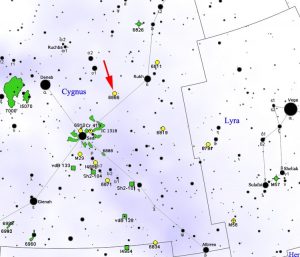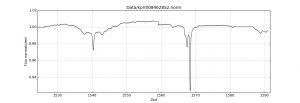Two years ago the star KIC 8462852, also know as Taby’s star created a bit of a sensation in the press and all over the web. The reason for all the excitement was the suggestion that the star’s irregular light curve, the amount of energy generated over time, could be explained by the existence of an ‘Alien Megastructure’ built around the star. Well Taby’s star is acting up again and we still know very little about the cause.
Let’s start with a few things we do know for certain. First of all KIC 8462852 is an F spectral type star in the constellation of Cygnus. Now the F spectral class is the next class bigger and brighter than our Sun, which is spectral class G. Taby’s star is in fact estimated to be about 1.5 times as massive as our Sun and about 5 times brighter. Despite its brightness however, at an estimated distance of 1300 light years Taby’s star cannot be seen with the unaided eye. The picture below shows Taby’s position in our sky.

In many respects KIC 8462852 should be just an average, normal main sequence star, a star as stable and constant as our own Sun. Taby’s star is anything but stable however, its brightness has been observed to drop by as much as 22% and even after years of observations astronomers have been completely unable to find any pattern in the variations of its light. The picture below shows KIC 8462852’s light curve for the 17th of April in 2013 as measured by the Kepler Space Telescope.

Several possible mechanisms for the variations in KIC 8462852’s brightness have been suggested. A system of one or more planets passing in front of the star can produce small and periodic dips in brightness; in fact this is how the Kepler space telescope has succeeded in discovering hundreds of planets outside our solar. However KIC 8462852 has larger reductions in it’s light output than could be caused by a planet, as much as 22% remember.
Other possible explanations include a swarm of asteroids or giant planets ‘flying in formation’ in highly eccentric orbits that sometimes bring them close to the star and other times take them far away from it. If the idea of three, four or more Jupiter sized planets orbiting as a group seems unlikely, well many astronomers agree with you. Bare in mind though, that astronomers have examined the light curves of millions of stars by now so it’s quite possible that Taby’s star is that one in a million oddball.
A recent suggestion has been made that the fluctuations in the light output from KIC 8462852 may be due to the star’s having swallowed a planet a couple of thousand years ago and in a sense its stomach is still upset.
Finally we have the proposed explanation that has everyone talking. There is a definite possibility that an alien supercivilization is building a structure similar to one described by Physicist Freeman Dyson and known as a Dyson Sphere. The idea of a Dyson Sphere is simple, in fact it’s the ultimate in solar power. By enclosing a star in a sphere an advanced civilization would have access to its entire energy output.
In this scenario the aliens are in the process of building the Dyson sphere around KIC 8462852 so that at present it is only capturing a small portion of the star’s total energy. This would still be more energy than the human race has used in its entire history.
All these possibilities are just that however, possibilities. We need more and more careful observations before we can make any kind of definite statement about the cause of the irregularity of Taby’s star. Since KIC 8462852 is now once again varying in brightness maybe soon we will learn more.
Before I go I do want to say one more thing. While much of what we know about KIC 8462852 comes from the Kepler space telescope or other professional observatories much of it has also come from observations by amateur astronomers. Throughout history these scientific hobbyists have discovered much of what we know about the Universe by their searches for comets or asteroids or by their measurements of the light curves of variable stars like Taby’s star.
